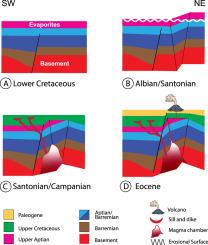Deciphering the complex history of the cabo frio high – SE brazilian continental margin
IF 1.7
4区 地球科学
Q3 GEOSCIENCES, MULTIDISCIPLINARY
引用次数: 0
Abstract
Extensive seismic reflection interpretation of the Cabo Frio High allowed better understanding of its proximal and distal structure. Seismic lines helped map the salt base and recognize the primary geological interfaces, unconformities, faults, and volcanic intrusions. The proximal Cabo Frio High is a continental basement uplift extending mainly into the Campos Basin. The Cabo Frio Outer High, which is of volcanic origin, lies between Santos and Campos Basins. This volcanism is concentrated at the crossing of two significant structures: Cruzeiro do Sul Lineament and Rio de Janeiro Fracture Zone. The Cabo Frio High fits an NW-SE fold axis, which is well correlated with distension along NW-SE direction generating a regional E-W sinistral plate movement, mainly related to the ENE-WNW sinistral Rio de Janeiro transfer zones. The accumulated uplift is approximately 4 km, achieved by at least four uplifting pulses. The uplifting starts in the Albian-Santonian, characterized by the elevation of the northeast portion of Cabo Frio High, followed by erosion. The sill and dikes intruded in the Upper Cretaceous, and the uplift of the southwest portion of the Cabo Frio High characterizes the second uplift pulse. Subaerial Eocene volcanos characterize the third uplifting pulse. The uplifting of the Blue Marker horizon (Oligocene) characterizes the last pulse.

解密卡布里奥高地--巴西东南大陆边缘的复杂历史
对卡博弗里奥高地进行了广泛的地震反射解释,从而更好地了解了其近端和远端结构。地震测线帮助绘制了盐基地形图,并识别了主要的地质界面、不连续面、断层和火山侵入体。卡博弗里奥高地近端是大陆基底隆起,主要延伸至坎波斯盆地。卡博弗里奥外高地源于火山,位于桑托斯盆地和坎波斯盆地之间。火山活动主要集中在两个重要结构的交叉处:Cruzeiro do Sul Lineament 和里约热内卢断裂带。卡博弗里奥高地符合西北-东南褶皱轴线,这与沿西北-东南方向的扩张密切相关,产生了区域性的东西向正弦板块运动,主要与 ENE-WNW 正弦里约热内卢转移带有关。累计隆起约 4 公里,由至少四个隆起脉冲实现。隆升始于阿尔卑斯-山童纪,其特点是卡博弗里奥高地东北部的抬升,随后是侵蚀。在上白垩世,山体和尖峰侵入,卡博弗里奥高地西南部的抬升是第二个抬升脉冲的特征。始新世的次生火山是第三个隆升脉冲的特征。蓝色标记地层(始新世)的隆起是最后一次隆起。
本文章由计算机程序翻译,如有差异,请以英文原文为准。
求助全文
约1分钟内获得全文
求助全文
来源期刊

Journal of South American Earth Sciences
地学-地球科学综合
CiteScore
3.70
自引率
22.20%
发文量
364
审稿时长
6-12 weeks
期刊介绍:
Papers must have a regional appeal and should present work of more than local significance. Research papers dealing with the regional geology of South American cratons and mobile belts, within the following research fields:
-Economic geology, metallogenesis and hydrocarbon genesis and reservoirs.
-Geophysics, geochemistry, volcanology, igneous and metamorphic petrology.
-Tectonics, neo- and seismotectonics and geodynamic modeling.
-Geomorphology, geological hazards, environmental geology, climate change in America and Antarctica, and soil research.
-Stratigraphy, sedimentology, structure and basin evolution.
-Paleontology, paleoecology, paleoclimatology and Quaternary geology.
New developments in already established regional projects and new initiatives dealing with the geology of the continent will be summarized and presented on a regular basis. Short notes, discussions, book reviews and conference and workshop reports will also be included when relevant.
 求助内容:
求助内容: 应助结果提醒方式:
应助结果提醒方式:


